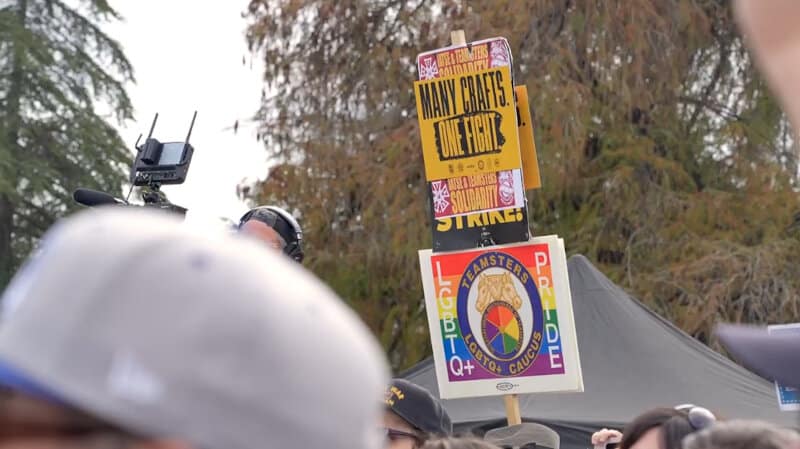2024 has been the most challenging year for Hollywood workers, game developers, and news journalists. Since April 2023, workers have seen the work of artificial intelligence (AI) tools have grown into an essential for workplace assistance. They soon experienced layoffs after their companies discovered generative AI programs. Corporations realized they could spend less on investments for their speed and efficiency.
The phenomenon continued to grow rapidly as creative artists saw the potential harm it could do. Soon, worker unions emerged to protest against generative AI in the media, gaming, and entertainment industries. 2024 has proven how much of their dedication is for guardrails while addressing fair benefits and necessary changes.
2022-2023: Significant Layoffs and AI Integration

Recovering Losses Through Job Cuts
In late 2022, media companies saw a massive layoff spike from September to December. Market Scale reported that industry leaders were trying to cut costs to stay afloat for streaming services investments and battle the advertisement recession. Companies like Discovery Inc. and Warner Bros. attempted to work together to expand their viewership profits.
These facts held true for the largest entertainment corporation, Disney removed 7,000 workers in February 2023. Disney CEO Bob Iger and his Wall Street shareholders recovered part of their $16.7 billion losses. Journalists have informed the public that industry leaders were restructuring their companies for financial success with provided content. However, industry writers and animators encountered another reason that pushed them into a union strike.
Replaced by Generative AI
According to The Animation Guild (TAG) 2023 Report, their AI Task Force investigated automated animation in April. They identified that having a machine that would replace animators in their production studios can cause more harm than progression. Generative programs like Chat GPT collect data from various sources around the Internet. Then, it randomly creates whatever its user commands it to do. This includes creative writing, recreating art pieces, and relaying news.
TAG first targeted Walt Disney Animation Studios to recognize the importance of their production staff. They failed to as over 100 animators and 12 representatives from their Rough Draft Studio division walked out to the studio’s parking lot. The staff that left communicated with the National Labor Relations Board and became part of the union.
Later, on May 1st, 2023, Marketplace Tech reported the Writers Guild of America (WGA) went on strike against the Alliance of Motion Picture and Television Producers (AMPTP). The week before, the union tried to negotiate a new 3-year tentative agreement. Their main demands were related to improving benefits:
- Increasing minimum wage by 6% (1st year) and 5% (2nd & 3rd year)
- Improve the greenlighting process (Both pre-production and post-production)
- Improve streaming service budgets for $12 million (AMPTP offered $40 million)
- Pension & Health Coverage for individual writers
- Regulate AI protection for Masters in Business Administration (MBA) programs, and written projects can’t be used to train or reproduced by it.
Most of their requests, including AI protection, were rejected. Despite needing a skilled programmer to train its functionality, AI became an opportunity for employers to pay less for workers while creating automated content.
Which Union Workers are Involved?
Generative AI tools quickly became more accessible and integrated into creative workspaces, especially in Hollywood. More worker unions joined the cause for guardrails on May 31st. These are the main five unions that are fighting for protection:
- IATSE (International Alliance of Theatrical Stage Employees)
- SAG-AFTRA (The Screen Actors Guild-American Federation of Television and Radio Artists)
- Writers Guild of America (WGA West and East)
- The Animation Guild (TAG)/Animation Workers Ignited
- Director’s Guild of America (DGA)
These unions are composed of experienced workers in the creative arts, including animation, acting, and video game development. Both laid-off and current employees banded together for the “Many Crafts, One Fight” initiative. They rallied for improved job security, worker benefits, increased minimum wages, fair pay, and generative AI protection. At the end of 2023, over 30,000 people lost their jobs, most of them working in media. The layoffs continued into 2024 alongside the 2024 Presidential Election.
2024: The Race to Protect Creative Artists

IATSE Cooperates with US Senate and House Representative
Since the discovery of generative AI in media and entertainment, IATSE Vice President Vanessa Holtgrewe has spoken to US Senate Majority Leader Chuck Schumer. His colleagues (Martin Heinrich, Mike Rounds, and Todd Young) assisted them in forming the AI Insight Forum on Nov. 29th, 2023. Their mission is to observe and recognize artificial intelligence’s threats to jobs operating through human communication and labor.
California Representative Adam Schiff joined IATSE’s cause and drafted the Generative AI Copyright Disclosure Act (GAICD Act). The bill states that any developer of a generative program must submit a detailed summary of any copyrighted works used to the Copyright Office. Artificial intelligence must prove that it has been trained to do a specific task. For any informative or artistic material, the developer has to credit the original source.
When Schiff introduced the GAICD Act on April 9th, 2024, many visual artists, including photographers and cartoonists, recognized the bill’s value. This would allow their works to be recognized under their name while the AI developers are credited as copycats. Then, from May 21st to May 22nd, Holtgrewe and Schumer discussed AI regulation policies for the new Area Standards Agreement (ASA) with the AMPTP.
The union later shared these values with its Canadian branch, IATSE 63, on May 28th. During this time, they sent their support to Institute of Contemporary Art (ICA) members. IATSE 63 successfully got the ICA to unionize to represent the country’s entertainment industry by majority vote. Unfortunately for the US, the AMPTP declined these needed regulations on June 1st. IATSE and their sister unions pressed on to fight for creative rights protection.
The 2024 US Presidential Election
2024 became a stressful year when US President Joe Biden announced Vice President Kamala Harris would take his place in the Presidential Election. IATSE kept a close eye on her and her opponent, former President Donald Trump, to see what their policy positions were on artificial intelligence regulations. Their precautions relate to the established executive order directed by Biden on Oct. 30th, 2023. Under “Policies and Principles,” Section 2-d states the following:
“[Biden’s] Administration cannot, and will not, tolerate AI to take advantage of those denied equal opportunity and justice. […] Far too often, we have seen it deepens discrimination and bias in the workforce. Using AI irresponsibly can result in online and physical harm. We have taken and built upon the necessary steps.”
Biden specified three bills that contributed to the Oct. 30th executive order: the Blueprint for an AI Bill of Rights, the AI Risks Management Framework, and Executive Order 14901 of February 16th, 2023. Together, these policies provide AI protection for certain work fields such as healthcare, law, and education. However, this did not stop production studios from using the tech to visualize future projects.
On July 30th, VOA News reported Trump’s and Harris’s approach to handling artificial intelligence development and tech. Trump told journalists at the Republican National Convention that he would repeal the Oct. 30th executive order if re-elected. He wants AI developers to thrive in generative work in the workforce and communications. He previously supported the idea in 2019 after realizing it would be everywhere. He made an executive order to establish generative programs for growing workers in tech development.
For Harris, she informed the press that she has been studying closely AI tech advancements. She kept her interests in mind on how it would affect the US’s work culture. When she was California’s attorney general, Harris befriended a couple of tech industry leaders, including Dr. Alondra Nelson. Nelson is responsible for drafting the Blueprint of AI Bill of Rights and helping the Biden Administration understand the risks. Harris promised she would continue working on improving AI protection if elected.
When the results of the 2024 Presidential Election were announced on Nov. 5th, the majority of US citizens voted for a second Trump term. This devastated IATSE and its sister unions for their push for change. Yet, they continued negotiating with AMPTP because their tentative agreements would sunset in December.
The Age of Generative Work
As the year comes to a close, the layoffs in the creative arts industry continue to rise. Wired shared that game developers suffered the most employee losses, with a 40% increase. These reasons were supported by game flops like Concord failing to become the next hero shooter. Until Microsoft attempted to shut down the successful indie game developer Tango Gameworks, the gaming community saw the rising problem.
For the companies who want to support one another’s work, their business leaders have to consider a project’s costs. To them, generative AI will be the solution for a more profitable gateway. Its ability to create anything in a few months or years will provide a steady flow of content. The downside is that there must be enough resources to gather around the Internet to complete its set tasks. Generative AI acts as a search engine that wants to offer users their best results. It creates a solution by gathering the top trends.
These tools have rapidly become open-sourced, allowing anyone to learn and utilize their functionality in the past two years. The next battle against the automated machines could be for journalism. On Dec. 17th, Family Feud host Steve Harvey was pronnounced dead by Trend Cast. Readers later learned that AI created the report, and Harvey himself posted a show clip on Instagram. The awareness of misinformation has grown stronger since 2020.
As for IATSE and their sister unions, the WGA and TAG recently received their new 3-year contract by vote. On Nov. 22nd, the WGA’s PBS members received their improved benefits, including access to healthcare and increased residual pay for reusing content on streaming services. They are also under AI protection to prevent the theft of their writers’ work.
TAG was met with disappointed animation fans when they learned what most of their members had voted for on Dec. 23rd. While they will be receiving their desired benefits, their creative works won’t have guardrails. This leaves individual and studio artists vulnerable to generative AI. Despite the consequences, 76.1% of TAG’s union did not want to spend another year for a fair contract.
2025 is going to be an uphill battle for nationwide creative art protection. IATSE will continue its fight for actors and entertainment industry workers. With Rep. Schiff taking oath as California’s US Senator, he will closely monitor Trump’s appeal of Biden’s AI executive order. He will continue to push for the GAICD Act while working for the state’s 13th Congressional District.








